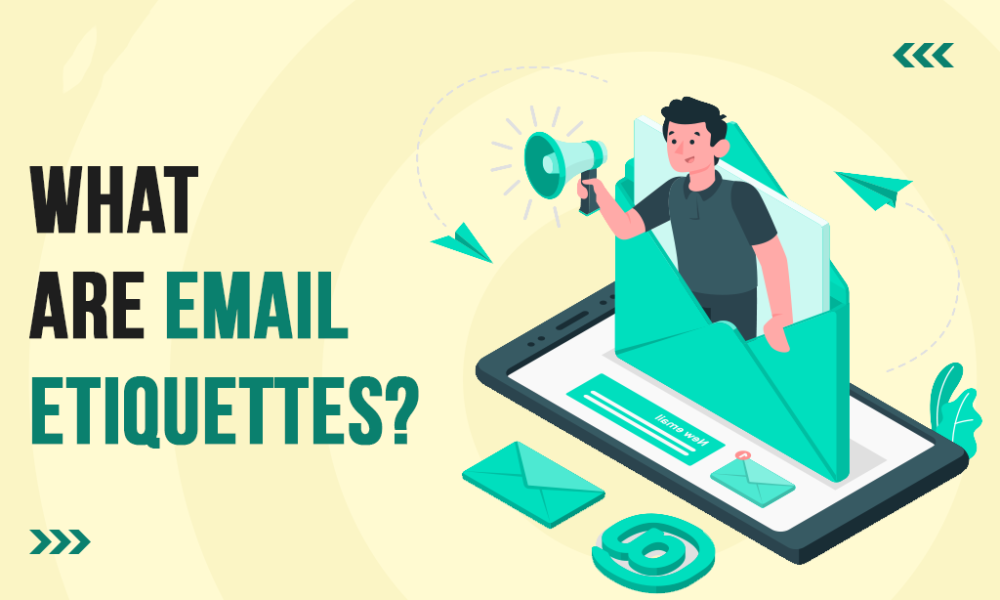Email Etiquette
- August 28, 2022
- By Anukriti Sharma
- Tips

“ Today, we can’t imagine our lives without email. We wake up responding to an email. We go to bed responding to someone’s email. Unfortunately, most schools do not teach us how to write a good email. This article is intended for those who want to improve their emailing skills. ”
What is email?
Email is an electronic mail that was first introduced in the 1960s. Back then, email communication was limited to users of the same computer. With the advent of technology and Wi-Fi, we can now send email from different devices hundreds of kilometers distant.
Now, in order to become really good email writers, we need to get better at this talent, which we are practicing every day.
Why do we need to be good at email?
Many of the things you will do after school, such as writing to your university, working on a project with your partners, or applying for an internship, will be done mostly through email.
This demonstrates your professionalism, ability to communicate in a foreign language, and ability to express yourself. This will connect to your receiver how and what you are feeling. Emailing is an important skill to learn because it will help you get better opportunities in the future.
PARTS OF AN EMAIL
1. Email Address:
Unless otherwise given, you should use some combination of your first and last name or just one of these two. It is permissible to add some numbers in cases where it has already been taken.
Avoid using words related to your interests or hobbies in a professional setting (e.g. doglover123 or spicegirl777). The recipient may not take your email seriously, or worse, they may not even attempt to open it because it appears to be spam, which may not be a good impression for you.
2. To:
The address of the person who will receive your email and must perform the action requested in your email. If you want to send an email to multiple people, enter all their email addresses here.
This line is intended for people who you expect to respond with a specific action or request. They have to respond to your email.
3. Cc (Carbon Copy)
A method for you to copy your email to someone else who you wanted to read it as well. However, you don’t necessarily expect them to act on that email.
You don’t expect them to tell you anything. You don’t expect them to share their thoughts with you. You simply want them to know that you sent this email to the recipient.
Example Scenario:
If you want your assistant to change your schedule but you also want to inform your work partners about this adjustment, you will put the email address of your assistant in the “To” line and add the email addresses of your work partners on the “Cc” line. This means that you are expecting your assistant to act, whereas your colleagues have only been informed.
4. Bcc (Blind Carbon Copy)
Those here can see who is in the “To” and “Cc” lines, but those in the “To” and “Cc” lines cannot see who is in the “Bcc” line.
Use with caution, especially if you want to protect the privacy of the people in this line.
Scenario (continued):
If you also want your boss or CEO to read this email but don’t want your assistant or colleagues to know their email address, use the Bcc line.
5. Subject
This is the summary of your email; what you wanted to be done. This should not be ignored even when in hurry.
Make this clear, precise, and brief. Try to limit this up to 10 words. This helps the receivers of your email with some background.
Examples:
- Change my schedule for this week
- URGENT!
- Interested in your Internship Program
6. Body of Email
Start your email with a greeting and/or salutation. If possible, include their first and last name. Take a note as well how their sign off their email as they might just want to be addressed by their first name. Below are some guides that we can use:
- “Dear” or “Dear Sir/Madam” – for a more formal email
- “Hi“ or “Hello” – writing to someone known to you; a less formal email
- “To whom it may concern” – writing for business correspondence
- “Dear All” – for multiple recipients (if at least two, you can include their names)
If this is your first time writing to a person, always introduce yourself to let them know who you are and why you are writing to them. This should be brief and straight to the point.
The most important part is the body paragraph. Make sure not to write lengthy-long emails. This can be permissible if you are writing to someone you haven’t seen for a long time. For most emails, especially formal ones, keep them short, clear, and straight to the point. However, you should still treat your email with love and respect.
- Always check the proper grammar, punctuation marks, or spelling errors.
- Do not use any emojis or smileys.
- Write in full long sentences.
- You can add formatting to emphasize some words such as important or urgent.
- Use legible font style and font size, and stay away from bright colors or highlights.
- Reread before sending.
Before sending the email, we can add a sign-off. This is also a sign to your receiver on how we wanted them to address you. We can use these in a formal email:
- Cordially
- Sincerely
- Best Wishes
- Best Regards
- Looking forward to hearing you soon
You can also add some information such as:
a. Contact Number
b. Company
c. Website
If you want to attach files to your email, you should ask permission first to send him/her during a formal email. If not, feel free to attach the file right away together with the email.
If you are attaching a large-sized file, you can convert them to a zip file to save some memory space. You can also opt to convert most files to PDF format to avoid incompatibility issues. I also recommend attaching the files first before creating the body paragraph of the email to make sure that the file will be sent together with the email.
Give yourself at least 24 hours to respond if you receive the email. If you are unable to respond for some reason, make sure to acknowledge the email and inform the sender that you will respond as soon as possible, letting the sender know that you received their email and will respond when you have time.
If you must respond, always double-check that you are sending your message to the intended recipients only, rather than hitting the Reply All button. This is done to avoid being in an awkward situation.
Be aware that emails stored in software programs are in the public domain. The company is the owner of the email, especially in corporate emails, and even if you delete it, they can still access it. As a result, you should handle email with caution. Make certain that no personal information is included in your corporate email.
Related Blogs

- August 31, 2022
- By Anukriti Sharma
HOTEL MANAGEMENT TIPS
HOTEL MANAGEMENT TIPS ByMs. Anukriti SharmaCommunication Skills and Etiquette Trainer WHAT IS HOTEL FRONT OFFICE DEPARTMENT The front office is the main.

- September 7, 2022
- By Anukriti Sharma
How to be self-disciplined
How to be self-disciplined ByMs. Anukriti SharmaCommunication Skills and Etiquette Trainer What is discipline? Discipline is a set of guidelines that aid.

